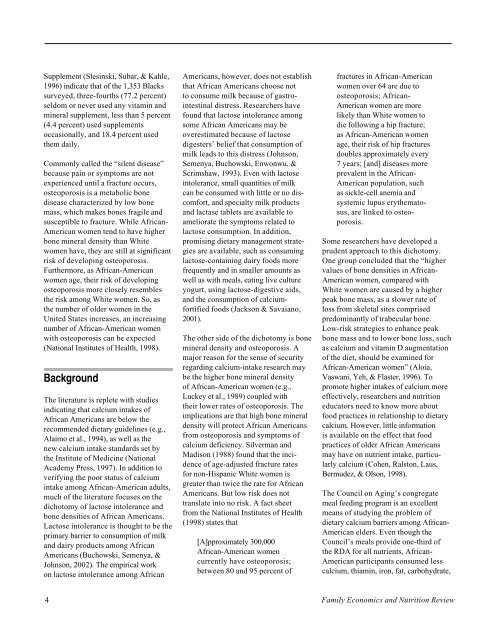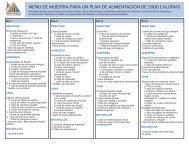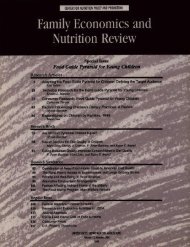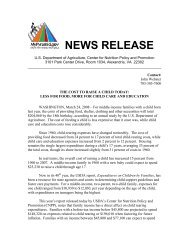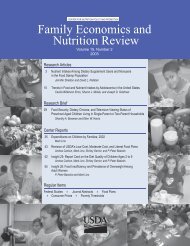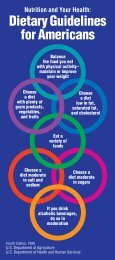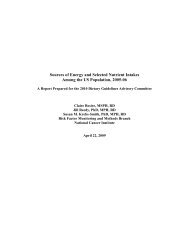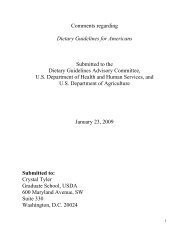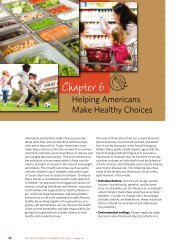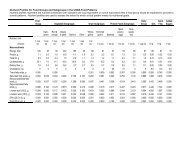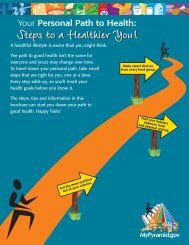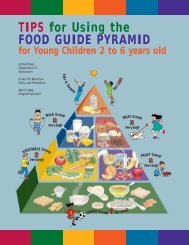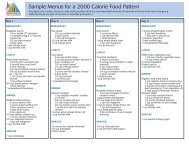Elderly Nutrition - Center for Nutrition Policy and Promotion - US ...
Elderly Nutrition - Center for Nutrition Policy and Promotion - US ...
Elderly Nutrition - Center for Nutrition Policy and Promotion - US ...
Create successful ePaper yourself
Turn your PDF publications into a flip-book with our unique Google optimized e-Paper software.
Supplement (Slesinski, Subar, & Kahle,<br />
1996) indicate that of the 1,353 Blacks<br />
surveyed, three-fourths (77.2 percent)<br />
seldom or never used any vitamin <strong>and</strong><br />
mineral supplement, less than 5 percent<br />
(4.4 percent) used supplements<br />
occasionally, <strong>and</strong> 18.4 percent used<br />
them daily.<br />
Commonly called the “silent disease”<br />
because pain or symptoms are not<br />
experienced until a fracture occurs,<br />
osteoporosis is a metabolic bone<br />
disease characterized by low bone<br />
mass, which makes bones fragile <strong>and</strong><br />
susceptible to fracture. While African-<br />
American women tend to have higher<br />
bone mineral density than White<br />
women have, they are still at significant<br />
risk of developing osteoporosis.<br />
Furthermore, as African-American<br />
women age, their risk of developing<br />
osteoporosis more closely resembles<br />
the risk among White women. So, as<br />
the number of older women in the<br />
United States increases, an increasing<br />
number of African-American women<br />
with osteoporosis can be expected<br />
(National Institutes of Health, 1998).<br />
Background<br />
The literature is replete with studies<br />
indicating that calcium intakes of<br />
African Americans are below the<br />
recommended dietary guidelines (e.g.,<br />
Alaimo et al., 1994), as well as the<br />
new calcium intake st<strong>and</strong>ards set by<br />
the Institute of Medicine (National<br />
Academy Press, 1997). In addition to<br />
verifying the poor status of calcium<br />
intake among African-American adults,<br />
much of the literature focuses on the<br />
dichotomy of lactose intolerance <strong>and</strong><br />
bone densities of African Americans.<br />
Lactose intolerance is thought to be the<br />
primary barrier to consumption of milk<br />
<strong>and</strong> dairy products among African<br />
Americans (Buchowski, Semenya, &<br />
Johnson, 2002). The empirical work<br />
on lactose intolerance among African<br />
Americans, however, does not establish<br />
that African Americans choose not<br />
to consume milk because of gastrointestinal<br />
distress. Researchers have<br />
found that lactose intolerance among<br />
some African Americans may be<br />
overestimated because of lactose<br />
digesters’ belief that consumption of<br />
milk leads to this distress (Johnson,<br />
Semenya, Buchowski, Enwonwu, &<br />
Scrimshaw, 1993). Even with lactose<br />
intolerance, small quantities of milk<br />
can be consumed with little or no discom<strong>for</strong>t,<br />
<strong>and</strong> specialty milk products<br />
<strong>and</strong> lactase tablets are available to<br />
ameliorate the symptoms related to<br />
lactose consumption. In addition,<br />
promising dietary management strategies<br />
are available, such as consuming<br />
lactose-containing dairy foods more<br />
frequently <strong>and</strong> in smaller amounts as<br />
well as with meals, eating live culture<br />
yogurt, using lactose-digestive aids,<br />
<strong>and</strong> the consumption of calcium<strong>for</strong>tified<br />
foods (Jackson & Savaiano,<br />
2001).<br />
The other side of the dichotomy is bone<br />
mineral density <strong>and</strong> osteoporosis. A<br />
major reason <strong>for</strong> the sense of security<br />
regarding calcium-intake research may<br />
be the higher bone mineral density<br />
of African-American women (e.g.,<br />
Luckey et al., 1989) coupled with<br />
their lower rates of osteoporosis. The<br />
implications are that high bone mineral<br />
density will protect African Americans<br />
from osteoporosis <strong>and</strong> symptoms of<br />
calcium deficiency. Silverman <strong>and</strong><br />
Madison (1988) found that the incidence<br />
of age-adjusted fracture rates<br />
<strong>for</strong> non-Hispanic White women is<br />
greater than twice the rate <strong>for</strong> African<br />
Americans. But low risk does not<br />
translate into no risk. A fact sheet<br />
from the National Institutes of Health<br />
(1998) states that<br />
[A]pproximately 300,000<br />
African-American women<br />
currently have osteoporosis;<br />
between 80 <strong>and</strong> 95 percent of<br />
fractures in African-American<br />
women over 64 are due to<br />
osteoporosis; African-<br />
American women are more<br />
likely than White women to<br />
die following a hip fracture;<br />
as African-American women<br />
age, their risk of hip fractures<br />
doubles approximately every<br />
7 years; [<strong>and</strong>] diseases more<br />
prevalent in the African-<br />
American population, such<br />
as sickle-cell anemia <strong>and</strong><br />
systemic lupus erythematosus,<br />
are linked to osteoporosis.<br />
Some researchers have developed a<br />
prudent approach to this dichotomy.<br />
One group concluded that the “higher<br />
values of bone densities in African-<br />
American women, compared with<br />
White women are caused by a higher<br />
peak bone mass, as a slower rate of<br />
loss from skeletal sites comprised<br />
predominantly of trabecular bone.<br />
Low-risk strategies to enhance peak<br />
bone mass <strong>and</strong> to lower bone loss, such<br />
as calcium <strong>and</strong> vitamin D augmentation<br />
of the diet, should be examined <strong>for</strong><br />
African-American women” (Aloia,<br />
Vaswani, Yeh, & Flaster, 1996). To<br />
promote higher intakes of calcium more<br />
effectively, researchers <strong>and</strong> nutrition<br />
educators need to know more about<br />
food practices in relationship to dietary<br />
calcium. However, little in<strong>for</strong>mation<br />
is available on the effect that food<br />
practices of older African Americans<br />
may have on nutrient intake, particularly<br />
calcium (Cohen, Ralston, Laus,<br />
Bermudez, & Olson, 1998).<br />
The Council on Aging’s congregate<br />
meal feeding program is an excellent<br />
means of studying the problem of<br />
dietary calcium barriers among African-<br />
American elders. Even though the<br />
Council’s meals provide one-third of<br />
the RDA <strong>for</strong> all nutrients, African-<br />
American participants consumed less<br />
calcium, thiamin, iron, fat, carbohydrate,<br />
4 Family Economics <strong>and</strong> <strong>Nutrition</strong> Review


